Migrant journey: 2021 report
Published 31 May 2022
This release explores changes in non-European Economic Area (non-EEA) migrants’ visa and leave status as they journey through the UK’s immigration system.
Key results
Almost a third (31%) of people issued an initial visa in 2016 still held valid temporary leave or settlement five years later at the end of 2021.
Migrants who were under 18 when issued an initial visa in 2016 were most likely to hold valid leave or settlement after five years (48%).
More than a quarter (29%) of people granted settlement in 2021 originally came to the UK on a Family visa.
Of the 33,000 people granted a Family visa in 2016, 83% still held valid leave or had been granted settlement at the end of 2021.
Of the 131,000 people initially granted a Work visa in 2016, just over a quarter (27%) still held valid leave or settlement at the end of 2021. However, the propensity to remain varied by route:
- 73% of people issued High value work visas still held leave after five years
- 34% of those issued Skilled worker visas
- 11% of those issued Temporary worker visas (99% of who had switched to a different route)
1. Introduction
This release explores patterns in non-European Economic Area (non-EEA) migrants’ visa and leave status as they journey through the UK’s immigration system, including data up to the end of 2021.
The report looks at the leave status of migrants each year from the point at which they were initially granted leave to enter the UK, any subsequent grants of extensions of stay within the UK, to settlement, citizenship, or leave expiry.
The report includes two types of analysis:
-
Forward-look – this looks at migrants who were initially granted a visa in 2016 or 2011 and their leave status at the end of 2021. See table MJ_D01 for the underlying data.
-
Backward-look – this looks at migrants who were granted settlement in 2021 and the visa they initially used to come to the UK. See table MJ_D02 for the underlying data.
Where the report talks about people having been granted settlement or indefinite leave to remain by the end of 2021 or after five or ten years, it includes those who have been granted British citizenship (either additionally or alternatively to settlement). In the accompanying dataset MJ_D01 the status ‘Indefinite leave to remain’ is further split into those granted settlement (but not citizenship) and those granted citizenship.
Where the report talks about people granted settlement in 2021, it refers only to grants of settlement and does not include grants of citizenship.
Where the report talks about people initially granted leave in 2011 or 2016, it means people granted leave in the main categories of Work, Sponsored study, Family, Dependants joining or accompanying, and Asylum.
Where the report mentions those grant Asylum, this does not include those on resettlement schemes, those granted discretionary leave, humanitarian protection, or any other form of protection. Asylum applications typically take longer to process than other routes so applicants may have been in the UK for some time before their grant.
The report focuses on the 5 year cohort, and for study 10 year, because this is the typical length of time after which people become eligible to apply for settlement.
The statistics in this report are based on information recorded on case working systems regarding an individual’s leave status. Although an indication, it is not possible to tell from this leave status whether the individual is currently still in the UK, or how much time they spend in the UK.
Where a migrant has consecutive leave, or where a subsequent period of leave starts no more than 12 months after the end of the previous period of leave, this is counted as one journey. Where a migrant has a period of 12 months or more between one leave expiring and the next beginning, this is counted as two separate journeys.
Further details can be found in the ‘Migrant Journey: user guide’ and accompanying data tables.
2. Overall trends
Key results
- Of people granted initial leave in 2016, 31% held valid temporary leave or indefinite leave to remain at the end of 2021 (5 years later) – typically 30 to 40% of those initially granted leave in a given year still hold some form of leave after five years (see Figure 1 below).
- Around 1-in-9 (11%) people granted leave in 2016 had been granted settlement after five years – numbers fell from from a high of 21% for the 2006 cohort to a low of 9% in 2013 and have since stabilised around 10 to 11%.
- Of those issued a visa in 2016, children (under 18s) were most likely to still hold valid leave or settlement after five years, and around half (48%) did so in 2021. Young adults, those aged 18-29, were the least likely (24%).
- The largest proportion of people granted settlement in 2021 originally arrived in the UK on a Family visa (29%), with Work visas a close second (28%).
Figure 1 shows a decrease in the number of grants of initial leave from 2011, and then levelling off from 2012. The proportion of people who had been granted settlement five years after their initial visa decreased, from 20% in the 2007-08 cohorts to 9% in 2013 and has remained relatively stable since – 11% in 2016.
Figure 1: Number of people granted initial leave in 2007 to 2016, broken down by their immigration status after five years
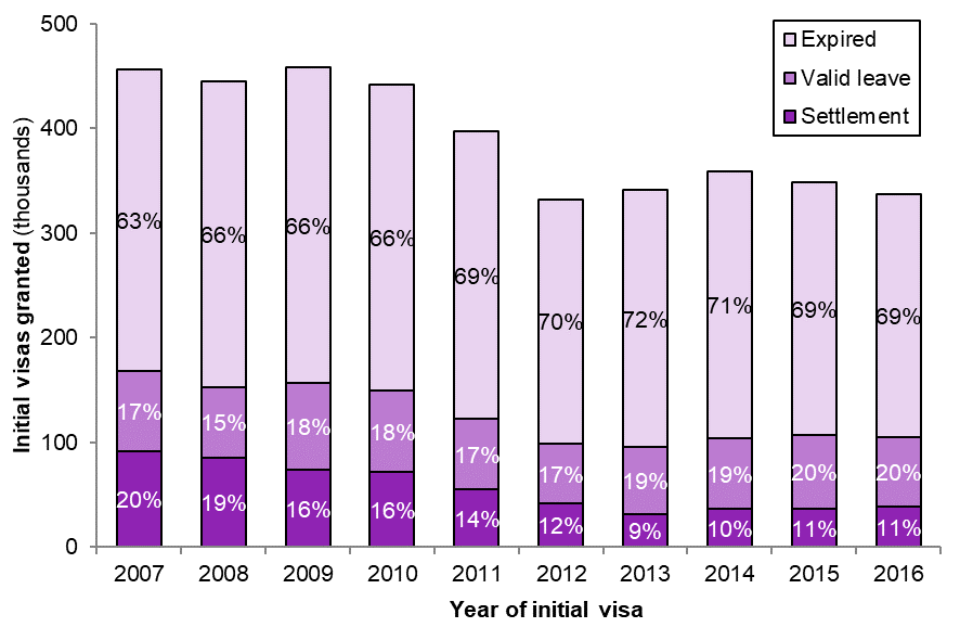
Source: Migrant Journey – Detailed Tables – MJ_D01
Notes:
- Percentages may not sum to 100% due to rounding.
In 2016, around 337,000 people were initially granted leave within the main categories. Of these, 38,000 (11%) had been granted settlement by the end of 2021 and a further 67,000 (20%) still held valid leave.
These proportions differ by initial leave category, as shown in Figure 2. The vast majority (83%) of people granted Family visas in 2016 still had valid leave or settlement at the end of 2021, compared to 27% of Work visas and 17% of Sponsored study visas.
Figure 2: Immigration status at end of 2021 of people initially granted leave in 2016, by initial visa type
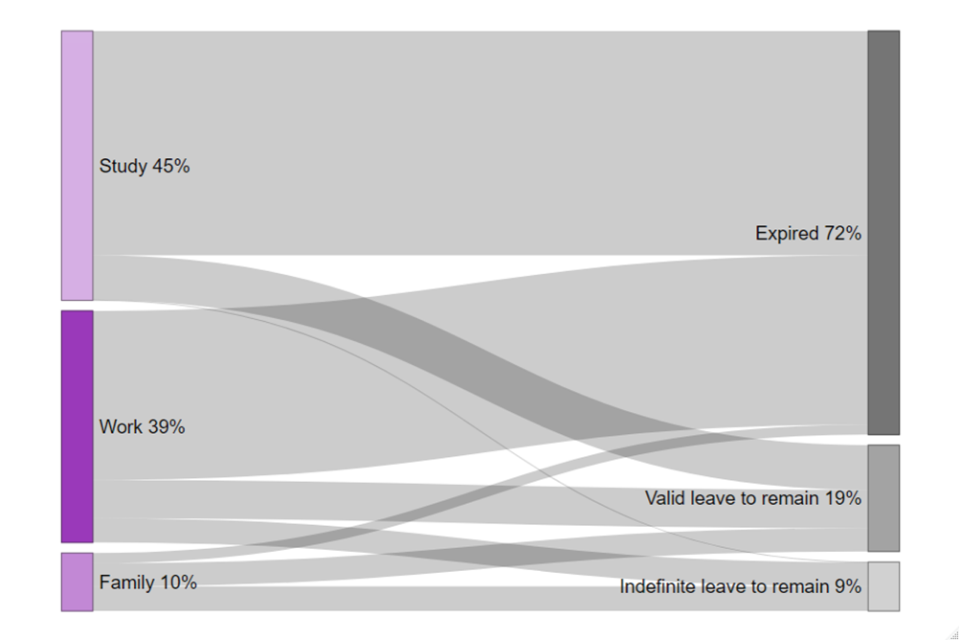
Source: Migrant Journey – Detailed Tables – MJ_D01
Notes:
-
Percentages on the left do not sum to 100% as the initial categories of ‘Dependants joining or accompanying’ and ‘Asylum’ are excluded from the chart.
-
‘Study’ excludes short-term study.
Under 18s were the age group most likely to hold valid leave or settlement after five years. Almost three-fifths (58%) of this age group issued visas in 2016 were dependants of another visa holder, rather than the main applicant, likely coming to the UK with their parents. This indicates that families with accompanying children are more likely to stay in the UK long term, extending their leave or applying for settlement.
Those aged between 18 and 29 were the least likely to hold valid leave or settlement after five years at 24%. This is in part likely related to the differences in age profiles of different visa categories, as shown in Figure 3. For example, 18 to 29 year olds made up 83% of Sponsored study visas and 76% of Temporary worker visas issued to main applicants in 2016, both of which are temporary routes without a direct path to settlement.
Figure 3: Proportion of people granted initial leave in 2016 broken down by their age when granted a visa, by initial leave type (excluding dependants)
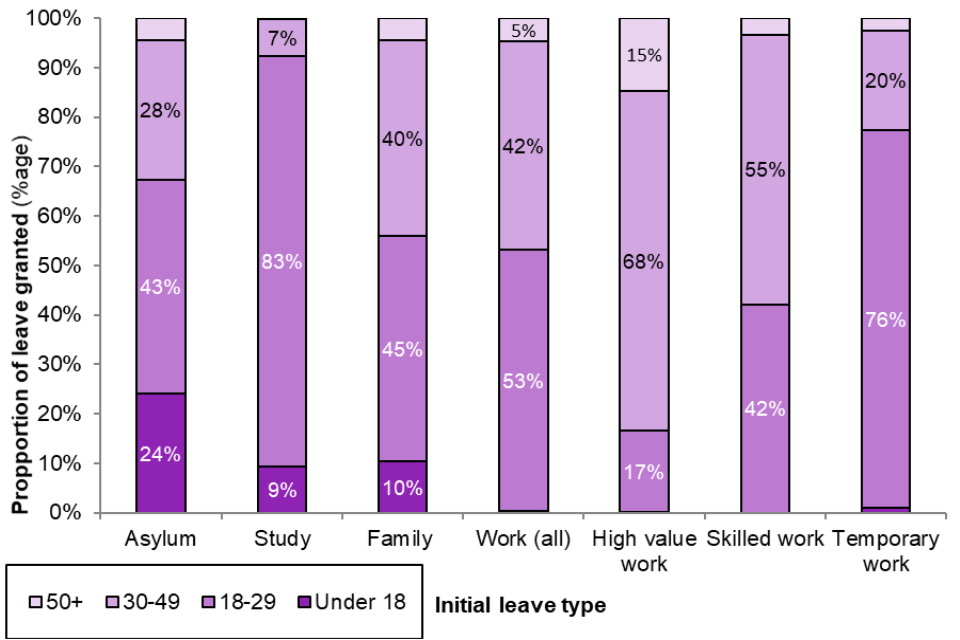
Source: Migrant Journey – Age and Sex Summary tables – MJ_03
Notes:
-
Dependant applications are not included in the chart.
-
Percentages may not sum to 100% due to rounding.
-
The ‘Work (all)’ category is the total of High value, skilled work, temporary work, and other work visas and exemptions categories.
-
Categories include pre-PBS equivalents.
The proportion of visas issued in 2016 which held valid leave or settlement after five years was the same for both males and females (31%).
To be granted settlement, individuals generally must have lived in the UK for a certain length of time in a qualifying category. People who have been living in the UK for 10 years on any combination of routes will be eligible for settlement after 10 years. Most people on work routes will become eligible after 5 years residence, though for some High value routes it is 2 or 3 years. Those on a family route may become eligible after 2, 5, or 10 years depending on when they arrived. Sponsored study doesn’t have a direct route to settlement, so those who go on settlement will usually have switched to another route or reached the 10 years needed for long residence.
Figure 4 shows that of the 109,000 people granted settlement in 2021, a little over a quarter had initially come for Family (29%), a similar proportion for Work (28%) reasons, just under a fifth (18%) came to study, around one in nine (11%) were recorded as having been refugees and the remainder (14%) came for other reasons.
Those initially on Family visa who were granted settlement in 2021 were most likely to have been granted their initial visa in 2015 and those on Work visas in 2016, that is respectively six and five years previously. This is a result of Family and Work migrants taking up the option for settlement soon after they become eligible after five years.
Those whose initial leave in the UK was a grant of asylum who were granted settlement in 2021 were also most likely to have received their initial grant in 2016, again this is likely to due those granted Asylum wanting to settle as soon as possible.
Meanwhile, those who settled in 2021 and had initially been granted Sponsored study visas were most likely to have been granted their initial visa in 2010. As Sponsored study is a temporary route, most former students (93%) subsequently switched into another route prior to applying for and receiving a grant of permanent settlement. 18% of settlement grants in 2021 were to people who originally came to the UK on a student visa similar to the previous year (17%), but lower than the proportions in the years 2015-2019 (27-28%) although similar to the level at the beginning of the last decade. (See Figure 5)
Figure 4: People granted settlement in 2021 by initial leave type
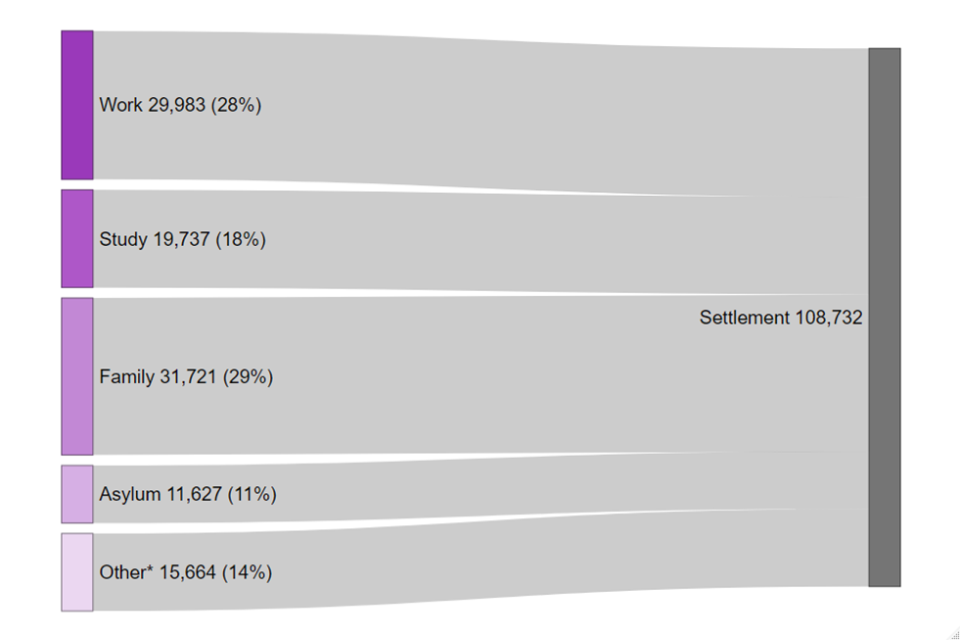
Source: Migrant Journey – Detailed Tables – MJ_D02
Notes:
- The ‘Other’ category contains grants of settlement to: Dependants joining or accompanying; visas for immediate settlement; EEA family permits; grants of non-Asylum protection, grants of leave outside the Immigration Rules, grants of discretionary leave, grants of private life; and other small miscellaneous categories.
Figure 5 shows the proportions of initial leave category of people granted settlement in each year from 2012 to 2021.
Figure 5: Common immigration categories of those granted settlement, 2012 to 2021

Source: Migrant Journey – Detailed Tables – MJ_D02
Notes:
-
Percentages may not sum to 100% due to rounding.
-
The ‘Other’ category contains grants of settlement where there had previously been grants of non-asylum protection, grants of leave outside the Immigration Rules, grants of discretionary leave, grants of private life, and other small miscellaneous categories.
-
Categories less than 5% have not been labelled on the chart.
Settlement rates also differ considerably by nationality. Of the top ten nationalities issued visas in 2016, Pakistani nationals had the highest proportion who had been granted settlement after five years (29%). The next highest were Filipino (19%) and Nigerian (11%) nationals, with the remaining nationalities in the top ten having a settlement rate of 8% or less after 5 years.
Of all those granted settlement in 2021, the largest number were originally from India (14%), Pakistan (11%) and Syria (7%) although these will have arrived in the UK on different routes.
A majority of Syrian nationals who were granted settlement in 2021 originally came to the UK under one of the refugee resettlement schemes (most likely through the Vulnerable Persons Resettlement scheme (VPRS)) or having been granted refugee status (asylum) or humanitarian protection following an asylum application, or as a partner or child of someone previously granted refugee status (asylum) or humanitarian protection. For more information on asylum and resettlement see the ‘How many people do we grant asylum or protection to?’ section of the Immigration Statistics.
Of all those granted settlement in 2021, a majority (60%) were between 30 and 49 years old, just less than a fifth (17%) were aged 18 to 29, 16% were under 18, and 7% were over 50. These proportions are shown in figure 6.
A slightly higher proportion were female (55%) than male (45%).
Figure 6: Age of people granted settlement in 2021

Source: Migrant Journey – Summary tables – MJ_05 and MJ_06
Covid-19 exceptional leave
On the 31 March 2020, as part of the response to the COVID-19 pandemic, the government announced that NHS frontline workers visas would be extended. On 29 April 2020, it was announced that other frontline health and care workers would also receive visa extensions. Healthcare professionals whose visas were due to expire between 31 March 2020 and 1 October 2020 were given a free, year-long extension. On 20 November, it was announced that this had been extended to cover visas expiring between 1 October 2020 and 31 March 2021. On 09 April it was announced that this would be extended to cover visas expiring up until 30 September 2021.
While these grants of extension of leave are included in this report it is not possible to separately identify them from other extension grants on the same routes. Home Office Management Information indicates that up to the end of 2021, there was a total of 19,823 extensions granted to health workers and care workers and their dependants, under these policies.
In addition to those granted extensions under existing policies, a separate policy for those currently unable to return home due to COVID-19 was announced on 17th February 2020, which was further extended on 24th March 2020 and again on the 22nd May 2020. 116,738 exceptional extensions were issued in 2020.
Starting from September 2020, people who intended to leave the UK but were unable due to travel restrictions were able to receive exceptional assurance which acts as short-term protection from adverse action or consequences after their leave expired. By the end of 2021 there had been 104,083 grants of such assurance, 24,484 in 2020 and 79,599 in 2021.
In total there were 220,821 grants of exceptional extensions and assurance by the end of 2021, granted to 147,529 individuals (27% received more than one grant). The breakdown of previous leave category for these people was:
- Visit – 66%
- Sponsored study – 17%
- Work – 8%
- No previous recorded leave – 6%
- Family – 1%
- Other – 1%
‘Other’ contains dependants joining or accompanying, grants of protection, leave outside the Immigration Rules, discretionary leave, private life, and other small miscellaneous categories. People may have had no previously recorded leave either because earlier leave was not matched to their exceptional grant or because they did not require leave to be in the UK (for example non-visa nationals who had planned to be in the UK for less than six months).
More than half (52%) of exceptional grants were to Chinese nationals, with 15% to Indian nationals.
Table 1: Top 5 nationalities issued Covid-19-related exceptional extensions and assurance in 2020 and 2021
| Nationality | People issued exceptional extensions and assurance |
|---|---|
| All nationalities | 147,529 |
| Of which: | |
| China | 76,831 |
| India | 22,837 |
| Nigeria | 5,197 |
| Australia | 2,865 |
| United States | 2,658 |
Source: Migrant Journey underlying datasets
These numbers differ from those seen in the quarterly immigration statistics where Exceptional Assurance is not included.
3. Sponsored study
The data in this section relate to:
- People granted an initial Sponsored study visa in 2011 and 2016, and examining their leave status in 2021 (table MJ_D01), by age and sex (tables MJ_01 to MJ_04)
- People granted settlement in 2021 who were initially issued a Sponsored study visa to come to the UK (table MJ_D02), by age and sex (tables MJ_05 and MJ_06)
References to ‘Sponsored study’ visas refer to the Student visa, the older Tier 4 visas, and their pre-PBS equivalents. Short-term study visas are excluded from this analysis. All figures include dependants unless otherwise stated.
Key results
- Five-year cohort: Of the 152,000 people granted a Sponsored study visa in 2016, 17% still held valid temporary leave at the end of 2021 – similar to the 2015 cohort (16%). Less than 1% had been granted settlement.
- Ten-year cohort: Of the 222,000 granted a Sponsored study visa in 2011, 7% still held valid temporary leave and 6% had been granted settlement at the end of 2021.
- Of all those granted settlement in 2021, 18% had initially been granted a Sponsored study visa; despite low rates of settlement compared to other visa categories, the large volume of foreign students means that they account for just under a fifth of total settlement cases in 2021.
Of people granted a Sponsored study visa in 2016, 17% still held valid leave at the end of 2021:
- 10% were continuing to study and remain on a Sponsored study visa
- 5% had switched to a Work visa
- 1% had switched to a Family visa
- 1% held other categories of visa
Of people issued an initial Study visa in 2016, 54% had expired leave after just two years. After five years, the proportion with expired leave increased to 83%, indicating that many people on Sponsored study visas will come to study and do not subsequently apply for permission to remain in the UK.
The proportion of people arriving on an initial Sponsored study visa who subsequently obtain a Work visa within the five years following their arrival as a student has decreased over time – from 13% of those granted a Sponsored study visa in the 2004 cohort to 5% in the 2016 cohort. This change is consistent with the tightening of Immigration Rules for students since September 2007. It also reflects changes in the composition of student migrants coming to the UK. For example, Chinese students accounted for 12% of those initially granted a Sponsored study visa in the 2004 cohort and had risen to 36% of the 2016 cohort. Chinese nationals are less likely than other nationalities to stay in the UK long term – 13% of Chinese nationals granted initial leave in 2016 had valid leave or settlement five years later, compared to 35% across all other nationalities.
Figure 7 shows that the majority of students’ leave had expired after five years, gradually increasing from 75% for the 2007 cohort to 83% for the 2016 cohort. It also shows that only a tiny proportion of students had been granted settlement after five years, from 1% for the 2007 cohort to less than 1% for 2016.
Figure 7: Number of people issued an initial Sponsored study¹ visa in 2007 to 2016, broken down by their immigration status after five years
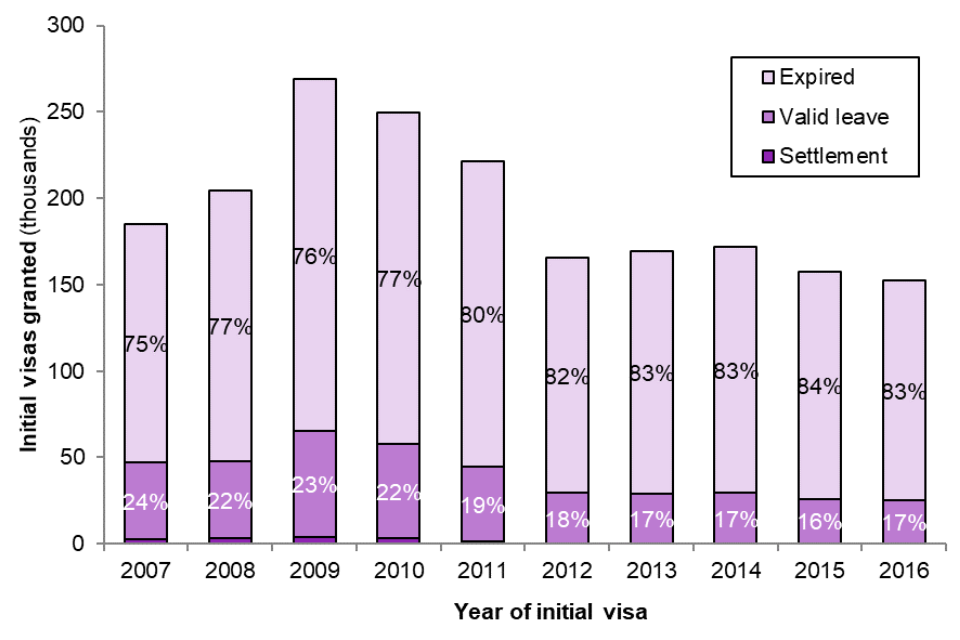
Source: Migrant Journey – Detailed Tables – MJ_D01
Notes:
-
Sponsored study and pre-PBS equivalents. Excludes Short-term study visas.
-
Categories less than 5% are not labelled on the chart.
-
Percentages may not sum to 100% due to rounding.
Those aged between 18 and 29 made up almost four-fifths (79%) of Sponsored study visas issued in 2016. Of this age group, only 13% still had valid leave at the end of 2021. Male students were slightly more likely to hold valid leave after five years, with 18% compared to 16% for female students.
Under 18s made up only 12% of Sponsored study visas issued in 2016 but this age group were the most likely to hold valid leave after five years – over a third (39%) still held a visa at the end of 2021. Of the under 18s issued Sponsored study visas in 2016, 29% were dependants of a main visa holder. Under 18s who were main visa holders were particularly likely to continue holding valid leave after five years (48%). This is likely because many of them come to study at schools, rather than universities, and therefore stay for a longer period to complete their education.
Less than 1% of those granted an initial Sponsored study visa in 2016 had been granted settlement by the end of 2021. Only a very small proportion of student visa holders are granted settlement within a five-year timeframe, as Study is not a direct route to settlement – a student would usually have to apply for another type of visa, for example by switching into skilled employment or through marriage, before being eligible for settlement.
After 10 years, the proportion of former students with settlement is greater; 6% of those granted an initial Sponsored study visa in 2011 had been granted settlement by the end of 2021. These visa holders will, in most cases, have subsequently switched into another route to permanent settlement or applied for settlement under the ten-year long-term residency rule. Only 7% of those granted settlement in 2021 who had initially been issued a Sponsored study visa, remained on a Sponsored study visa immediately prior to being granted settlement. Two-fifths (40%) had switched to a Work visa and a similar proportion (37%) had switched to a Family visa, with 8% having been granted Asylum.
Although the settlement rate for student visa holders is low compared to people on Work and Family visas, the volume of Sponsored study visas issued is much larger than other categories. As a result, of those granted settlement in 2021, 18% had originally entered the UK on a Sponsored study visa. They were most likely to have been granted their initial Sponsored study visa in 2010, demonstrating the longer route to settlement for Study migrants.
Of the top five nationalities issued Sponsored study visas in 2011 (who together accounted for 61% of total Sponsored study visas granted), Pakistani and Nigerian nationals had the highest proportion who still had valid leave five years later.
Table 2: Top 5 nationalities issued an initial Sponsored study¹ visa in 2011
| Visa category | People in 2011 cohort | % with expired leave after five years | % with valid leave after five year | % granted settlement after five years |
|---|---|---|---|---|
| All nationalities | 221,636 | 87% | 7% | 6% |
| Of which: | ||||
| China | 41,795 | 96% | 2% | 2% |
| Pakistan | 34,910 | 76% | 13% | 10% |
| India | 33,038 | 85% | 8% | 6% |
| United States | 13,648 | 95% | 2% | 3% |
| Nigeria | 11,003 | 79% | 11% | 10% |
Source: Migrant Journey – Detailed Tables – MJ_D01
Notes:
-
Sponsored study visas and pre-PBS equivalents. Excludes Short-term study visas.
-
Percentages may not sum to 100% due to rounding.
Of all those granted settlement in 2021 who had initially entered on a Sponsored study visa, the most common nationalities were Indian (15%), Pakistani (14%) and Chinese (10%).
Of those granted settlement in 2021 who had initially entered on a Sponsored study visa, 74% were between 30 and 49 years old when granted settlement. This is despite the majority of Sponsored study visas being issued to 18 to 29 year olds. This is likely related to the longer path for settlement for Study migrants, meaning they are often 10 or more years older by the time they are granted settlement.
Figure 8 shows that just over three quarters (76%) of people issued Sponsored study visas in 2012 has expired leave after 5 years, rising to 90% after 10 years which implies that the majority of people who came the UK to study in the last ten years did not seek to remain in the UK after their studies.
Figure 8: Subsequent leave status of people issued Sponsored study visas in 2012
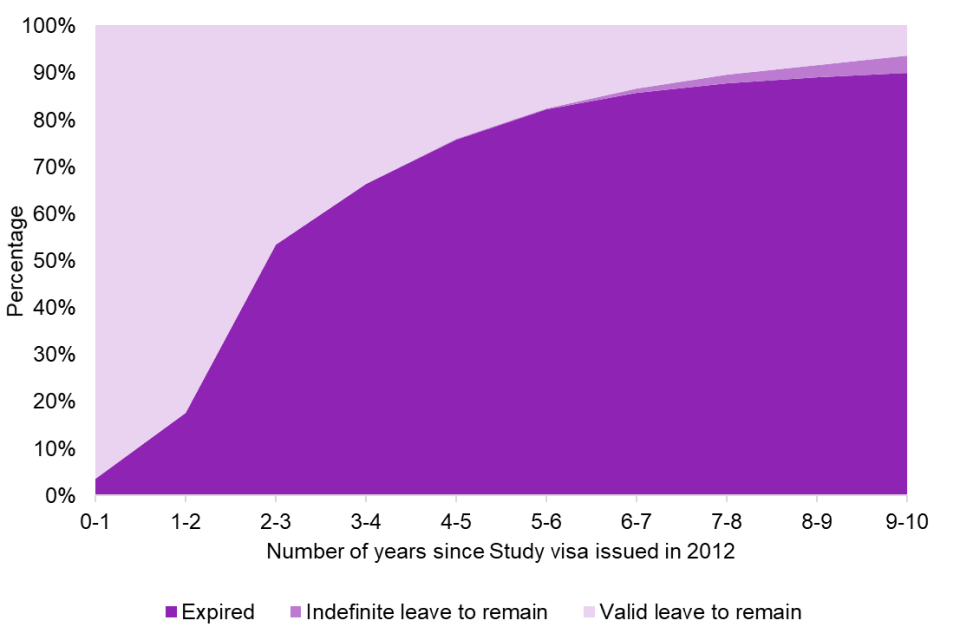
Source: Migrant Journey – Detailed Tables – MJ_D01
Of those people who initially came to the UK on a Sponsored study visa in 2012 and continued to hold valid leave for more than 5 years but had not obtained ILR, some extended their study visas while others switch into other routes. Figure 9 shows that after 5 years, 75% were still on a Sponsored study visa with 13% having switched to a work route. After 10 years, only one in six (16%) were still on the study route with most having switched to work (33%) or family (27%) routes. 7% of students who arrived in 2012 and continued to hold temporary valid leave at the end of 2021 had since been granted asylum.
Figure 9: Subsequent leave category of people issued Sponsored study visas in 2012 who continued to hold valid leave to remain but not indefinite leave to remain
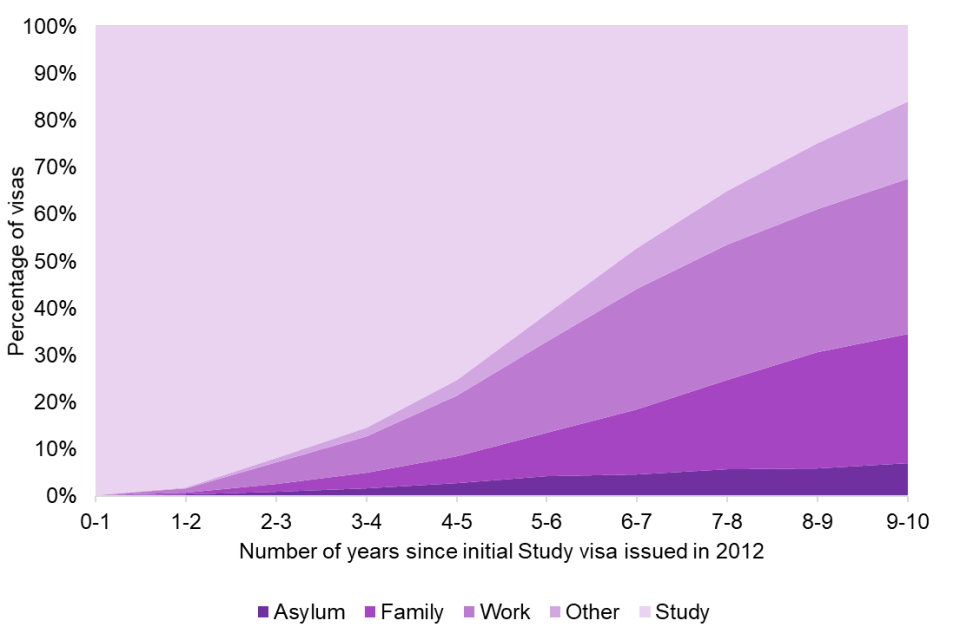
Source: Migrant Journey – Detailed Tables – MJ_D01
4. Work
The data in this section relate to:
- People granted an initial Work visa in 2016 and examining their leave status in 2021 (table MJ_D01), by age and sex (tables MJ_03 and MJ_04)
- People who were granted settlement in 2021, who were initially issued a Work visa to come to the UK (table MJ_D02), by age and sex (tables MJ_05 and MJ_06)
All references to ‘High value’, ‘Skilled worker’, ‘and ‘Temporary worker’ visas include ‘Tier 1’, ‘Tier 2’ and ‘Tier 5’ respectively as well as their pre-PBS equivalents. All figures include dependants unless otherwise stated.
Key results
- Of the 131,000 people granted a Work visa in 2016, around a quarter (27%) still held valid leave or had been granted settlement by the end of 2021, a similar proportion to the preceding year’s cohort.
- 10% of people granted a Work visa in 2016 had been granted settlement after five years, a similar level to the 2015 (9%) and 2014 (10%) cohorts of Work migrants.
- For people issued High value visas in 2016, 73% still held valid leave or settlement after five years, compared to 34% of those issued Skilled worker visas and 11% of those issued Temporary worker visas.
- Of all those people granted settlement in 2021, just over a quarter (28%) had initially arrived on a Work visa, slightly higher proportion to 2019 and 2020 (both 25%).
At the end of 2021, around a quarter (27%) of people who initially came to the UK in 2016 on a Work visa held valid leave or settlement:
- 14% remained on a Work visa
- 3% had switched to a different category of visa
- 10% had been granted settlement
The remaining 73% of people issued Work visas in 2016 had expired leave by the end of 2021 (See figure 10).
Figure 10: 2021 status of people granted work visas in 2016

Source: Migrant Journey – Detailed Tables – MJ_D01
Under 18s issued Work visas in 2016 were the age group most likely to hold valid leave or settlement five years later (38%). However, most (98%) of these were dependants accompanying someone else on a Work visa, such as their parents. This may indicate that Work migrants who bring children with them are more likely to stay in the UK long term. For other ages groups the proportion of those holding valid leave or settlement after five years was between 19% and 28%.
At the end of 2021, 28% of females issued Work visas in 2016 held valid leave or settlement, compared to 26% of males.
Figure 11 shows that for each cohort of Work migrants from 2007 to 2016, a large majority (between 69% and 77%) had no leave to remain five years later.
Figure 11: Number of people issued an initial Work visa in 2007 to 2016, broken down by their immigration status after five years

Source: Migrant Journey – Detailed Tables – MJ_D01
Notes:
- Percentages may not sum to 100% due to rounding.
People arriving on the High value routes had the highest proportion of individuals with valid leave or settlement after five years (73%), although this category also represents the smallest number of Work visas issued. The High value route has focused on providing visas such as the exceptional talent route, investors and entrepreneurs.
By comparison, there was a much lower proportion of valid leave or settlement for people on the Skilled worker route (34%). The proportion was even lower for people on the Temporary route (11%) which had a very small number of settlement cases.
Table 3: People issued an initial Work visa in 2016, broken down by work category
| Visa category | Migrants in 2016 cohort | % with expired leave after five years | % with valid leave after five years | % granted settlement after five years |
|---|---|---|---|---|
| All categories | 130,874 | 73% | 17% | 10% |
| Of which: | ||||
| High value | 3,623 | 27% | 34% | 39% |
| Skilled worker | 78,773 | 66% | 20% | 14% |
| Temporary worker | 36,213 | 89% | 11% | 0% |
| Other work visas and exemptions | 12,265 | 82% | 6% | 11% |
Source: Migrant Journey – Detailed Tables – MJ_D01
Notes:
-
Tier 1, Tier 2 and Tier 5 totals include pre-PBS equivalents.
-
Percentages may not sum to 100% due to rounding.
-
The ‘Other work visas and exemptions’ category includes new routes other than Skilled work and older routes such as European Community Association Agreement (ECAA) businessperson, domestic workers in private households, UK Ancestry visas and pre-PBS routes that are now closed.
Of all those granted settlement in 2021, just over a quarter (28%) had initially been granted a Work visa. They were most likely to have been granted their Work visa in 2016, with people applying for settlement as soon as they were eligible after five years.
Due to their higher settlement rate, High value workers made up 16% of people granted settlement in 2021 who had initially entered on a Work visa, despite making up less than 10% of those granted work visas. High value workers granted settlement in 2021 were most likely to have an initial grant in 2016, though many were also granted in 2015 and 2014.
Skilled workers have a lower settlement rate but account for a much larger proportion of Work visas issued, hence over two-thrids (69%) of workers granted settlement in 2021 had entered on Skilled worker visas. The remaining 15% of settlement cases in 2021 who been issued initial Work visas, entered the UK originally on a Temporary worker (8%) or other non-PBS (7%) Work visa and subsequently switched to another visa type.
Skilled work
Skilled worker visas accounted for over half (60%) of Work visas issued in the 2016 cohort. 14% of people on this route had been granted settlement within five years, slightly higher than the 2015 cohort (12%). However, the proportion of Skilled workers granted settlement within five years remains much lower than 2009 levels (23%).
The proportion of Skilled workers who had been granted settlement within five years differs by nationality. These differences will be a result of the types of jobs people come to the UK for, the number coming under the Intra-company Transfer (ICT) route,[footnote 1] which does not have a direct route to settlement, as well as differences in nationalities desire to settle in the UK. Of the top 10 nationalities granted Skilled work visas in 2016, Japanese nationals had the highest proportion of ICT visas (88%), along with the lowest proportion of people granted settlement after five years (2%). Pakistan had the lowest proportion of ICT visas (8%) and the highest proportion granted settlement after five years (50%).
Table 4: Top 10 nationalities (by volume) issued an initial Skilled worker visa in 2016, ordered by proportion granted settlement
| Nationality | People in 2016 cohort | Proportion of Skilled worker visas issued which were ICTs | % with expired leave after five years | % with valid leave after five years | % granted settlement after five years |
|---|---|---|---|---|---|
| All nationalities | 78,773 | 65% | 66% | 20% | 14% |
| Of which: | |||||
| Pakistan | 1,429 | 8% | 20% | 30% | 50% |
| Philippines | 2,237 | 14% | 24% | 32% | 44% |
| Russia | 1,129 | 24% | 41% | 19% | 40% |
| South Africa | 1,546 | 23% | 45% | 22% | 33% |
| China | 1,937 | 41% | 66% | 17% | 17% |
| Canada | 1,156 | 29% | 63% | 21% | 16% |
| Australia | 2,039 | 23% | 63% | 22% | 15% |
| United States | 8,327 | 53% | 71% | 19% | 10% |
| India | 45,713 | 84% | 73% | 19% | 8% |
| Japan | 3,251 | 88% | 83% | 15% | 2% |
Sources:
Migrant Journey – Detailed Tables – MJ_D01
Entry clearance visa applications and outcomes – Vis_D02
Notes:
-
Skilled worker visa totals include pre-PBS equivalents.
-
ICT figures sourced from the quarterly Home Office ‘Immigration Statistics’ publication.
Of all those granted settlement in 2021 who had initially entered on a Work visa, the top nationalities were India (29%), Pakistan (8%) and the USA (7%).
Just over two-thirds (69%) of those granted settlement in 2021 who had initially entered on a Work visa were aged between 30 and 49 years old when granted settlement.
A slight majority (55%) of those granted settlement in 2021 who had initially entered on a Work visa were female.
Of those granted settlement in 2021 who had initllay entered on a work visa, 84% were still on a work route when they applied for settlement, 12% had switched to a family route, and 4% had switched into other routes.
5. Family
The data in this section relate to:
- People granted an initial Family visa in 2016 and examining their leave status in 2021 (table MJ_D01), by age and sex (tables MJ_03 and MJ_04)
- People initially issued a Family visa to come to the UK and who were granted settlement in 2021 (table MJ_D02), by age and sex (tables MJ_05 and MJ_06)
Key results
- Of the 33,000 people granted a Family visa in 2016, 83% held valid leave or settlement at the end of 2021, much higher than other non-Asylum categories of visa. This is a lower proportion than the 2015 cohort (89%).
- Under 18s who arrived on a Family visa were more likely (89%) than other age groups (82%) to hold valid leave or settlement five years later.
- Of people granted a Family visa in 2016, 42% had been granted settlement by the end of 2021, a much lower rate compared to earlier cohorts 2008-2011 (range of 79-82%).
- Of all those granted settlement in 2021, 29% had initially been granted a Family visa, another 13% had switched to a Family route prior to applying for settlement.
At the end of 2021, 83% of people granted a Family visa in 2016 held valid leave or settlement:
- Over a third (37%) remained on a Family visa
- 3% had switched to a different category of visa
- More than two-fifths (42%) had been granted settlement
The remaining 17% of people issued Family visas in 2016 had expired leave by the end of 2021 (see figure 12).
Figure 12: 2021 status of people granted family visas in 2016
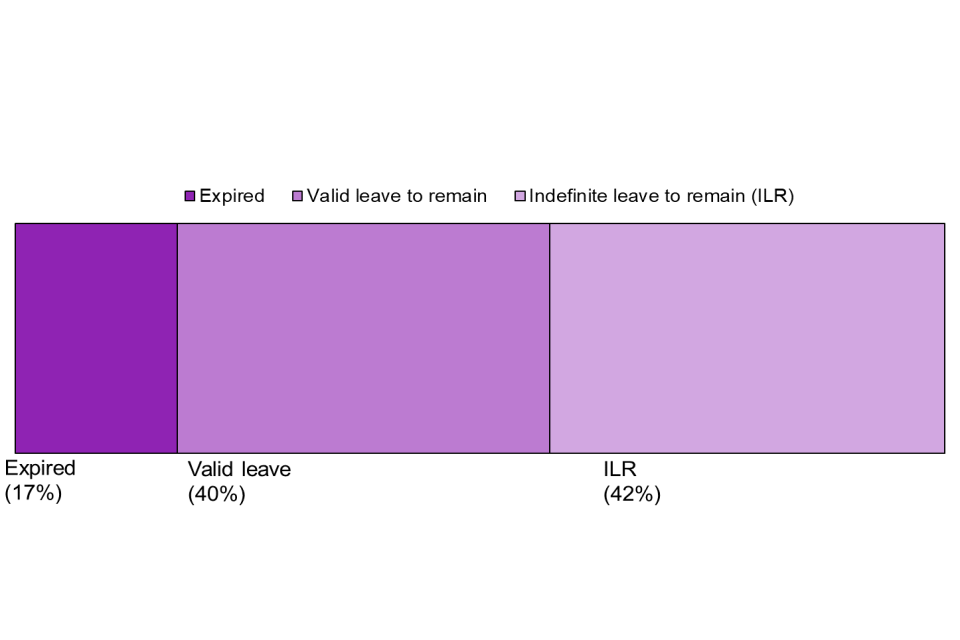
Source: Migrant Journey – Detailed Tables – MJ_D01
Notes:
- Percentages may not sum to 100% due to rounding.
The proportion of people granted a Family visa in 2016 who had been granted settlement five years later (42%) was a much higher than the 2015 cohort (32%). Although this is an increase from the previous year, the rate is still much lower compared to the earlier cohorts 2008-2011 (range of 79-82%). This change can to some degree be accounted for by changes in July 2012 to the Immigration Rules for Family visas, which changed the eligibility period for settlement from two years to five years.
Under 18s issued Family visas in 2016 were the most likely to hold valid leave or settlement five years later at 89% compared to 82% for over adults. Females accounted for 71% of Family visas issued in 2016, though there was little difference between the sexes in the proportion of those who held valid leave or settlement at the end of 2021.
Figure 13 shows that the proportion of people who initially came on a family visa who still held some form of leave after five years has been fairly consistent for people arriving in each year between 2007 and 2016. However, the proportion of people holding indefinite leave to remain after five years fell between 2012 and 2015, with a corresponding increase in the proportion holding temporary valid leave to remain. This followed the mid-2012 immigration rule changes which introduced the 10-year family route.
Figure 13: Proportion of people issued an initial Family visa in each year 2007 to 2016, by their immigration status after five years
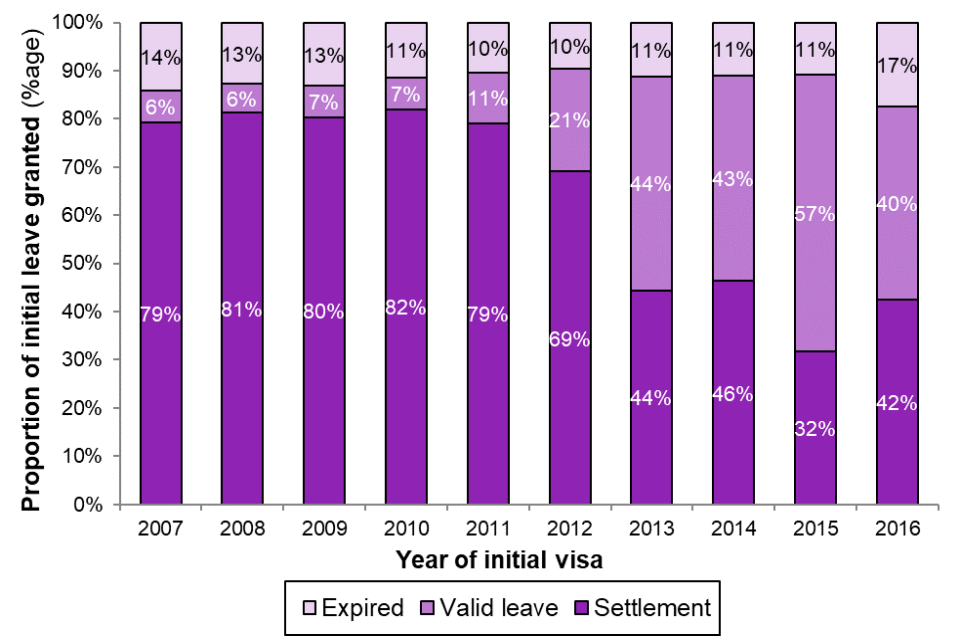
Source: Migrant Journey – Detailed Tables – MJ_D01
Notes:
- Percentages may not sum to 100% due to rounding.
Of the top five nationalities issued Family visas in 2016 (accounting for 41% of total Family visas granted), Syrian nationals had the highest proportion with settlement after five years (83%). Almost all Syrian nationals initially issued a family visa in 2016 were granted Family Reunion visas, which are issued to partners and children of those previously granted refugee status (asylum) or humanitarian protection in the UK.
A relatively low proportion (14-16%) of nationals of India, Pakistan and Bangladesh had expired leave within five years of their initial Family Visa, whereas for American nationals this rose to almost a third (32%).
Table 5: Top 5 nationalities (by volume) issued an initial Family visa in 2016
| Visa category | People in 2016 cohort | % with expired leave after five years | % with valid leave after five years | % granted settlement after five years |
|---|---|---|---|---|
| All nationalities | 32,777 | 17% | 40% | 42% |
| Of which: | ||||
| Pakistan | 5,791 | 16% | 49% | 35% |
| India | 2,586 | 14% | 45% | 41% |
| Syria | 1,967 | 13% | 4% | 83% |
| United States | 1,870 | 32% | 38% | 29% |
| Bangladesh | 1,178 | 16% | 53% | 31% |
Source: Migrant Journey – Detailed Tables – MJ_D01
Of all people granted settlement in 2021, 29% had been initially granted a Family visa, the largest of any initial route. Just under a third (31%) of these were issued their initial Family visa in 2016, suggesting these people applied for settlement as soon as they become eligible after five years, with a further 41% issued a visa in 2015.
Of all those granted settlement in 2021 who had initially entered on a Family visa, the top nationalities were Pakistani (16% of the total in that year) and Indian (10%).
Similar to the Sponsored study and Work visa categories, the majority (65%) of those granted an initial Family visa who had been granted settlement in 2021 were aged between 30 and 49. Most (72%) were female, which is consistent with the proportion of Family visas issued to female migrants in 2016 (71%).
6. Asylum
The data in this section relate to:
- People initially granted asylum in 2016 and examining their leave status in 2021 (table MJ_D01), by age and sex (tables MJ_03 and MJ_04)
- People initially granted asylum who were granted settlement in 2021 (table MJ_D02), by age and sex (tables MJ_05 and MJ_06)
Key results
- Of the 13,000 people initially granted Asylum in 2016, almost all (over 99%) still held valid leave or settlement in the UK at the end of 2021.
- Almost two-thirds (64%) had been granted settlement by the end of 2021, with the remaining 36% holding other valid leave to remain.
- Of people granted Asylum in 2011, nearly all (96%) had been granted settlement by the end of 2021.
- An additional 849 people who started their journey in 2016 on a non-Asylum route were granted Asylum after their initial grant of leave, 99% of whom still held valid leave at the end of 2021.
- Almost three quarters (72%) of people granted Asylum in 2016 were male, and the most common age group was 18-29 at 43%.
People granted Asylum are far more likely to continue to hold valid leave or have been granted settlement than those who came on other routes. Of the 13,356 people granted Asylum in 2016, 36% held valid leave to remain at the end of 2021 and 64% had already been granted settlement.
The proportion granted settlement is even higher after 10 years with 96% of people granted Asylum in 2011 having been granted settlement by the end of 2021. Figure 14 shows that the majority (87%) of people granted Asylum in 2011 were granted settlement five to seven years later.
Figure 14: Leave status of people granted Asylum in 2011 at the end of each subsequent year

Source: Migrant Journey – Detailed Tables – MJ_D01
In addition to those whose were initially granted Asylum, 849 people who started their journey in 2016 on other routes were later granted asylum.
Of these 849 people:
- 59% came initially on a Sponsored study route
- 21% came on Work
- 10% came on Family
- 10% came on other routes
Of the top five nationalites initially granted Asylum in 2016 (who together accounted for 68% of the total), Syrian (81%) and Sudanese (76%) nationals were the most likely to have been granted settlement by the end of 2021.
Table 6: Top five nationalities (by volume) initially granted Asylum in 2016
| Nationality | People in 2016 cohort | % with expired leave after five years | % with valid leave after five years | % granted settlement after five years |
|---|---|---|---|---|
| All nationalities | 13,356 | 0% | 36% | 64% |
| of which: | ||||
| Iran | 2,403 | 0% | 39% | 60% |
| Eritrea | 2,348 | 0% | 51% | 49% |
| Syria | 1,763 | 0% | 19% | 81% |
| Sudan | 1,408 | 0% | 24% | 76% |
| Afghanistan | 1,108 | 0% | 41% | 59% |
Source: Migrant Journey – Detailed Tables – MJ_D01
Almost three-quarters (72%) of people initially granted Asylum in 2016 were male.
The most common age group for of the initially granted Asylum in 2016 was 18-29 with 43% of the total, only 4% were over 50 years old.
Figure 15: Age of people initially granted Asylum in 2016
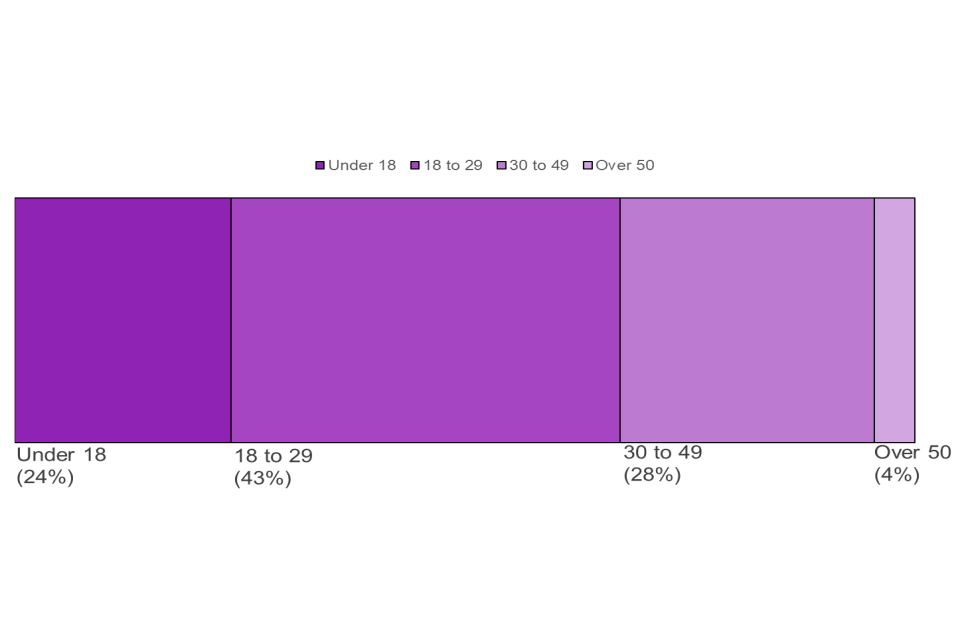
Source: Migrant Journey – Summary Tables – MJ_04
Of all people granted settlement in 2021, 11% were initially granted Asylum. The majority of whom (68%) were initially granted Asylum in 2016, suggesting these people applied for settlement as soon as they became eligible after five years, with a futher sixth (17%) granted Asylum in 2015.
7. Further information and enquiries
The data are presented in two detailed data tables:
- Table MJ_D01: End-of-year category and immigration status of all applicants issued leave by year of initial grant, category of initial leave and country of nationality. Persons starting on Visit visas, visas for immediate settlement and other smaller miscellaneous entry clearance routes (e.g. EEA family permits) are excluded.
- Table MJ_D02: People granted settlement by year of settlement grant, initial leave category and country of nationality. Persons arriving as visitors or for short-term study are excluded.
This release also includes data on the age and sex of people, following their introduction to the series two years ago. These data are presented in the following summary tables:
- Table MJ_01: Status of those issued initial leave in 2011 at the end of 2021, by initial leave category and age at initial grant.
- Table MJ_02: Status of those issued initial leave in 2011 at the end of 2021, by initial leave category and sex.
- Table MJ_03: Status of those issued initial leave in 2016 at the end of 2021, by initial leave category and age at initial grant.
- Table MJ_04: Status of those issued initial leave in 2016 at the end of 2021, by initial leave category and sex.
- Table MJ_05: Grants of settlement in 2021 by year of initial grant, initial leave category and age at time of settlement.
- Table MJ_06: Grants of settlement in 2021 by year of initial grant, initial leave category and sex.
- Table MJ_07: People with valid leave to remain other than ILR or Citizenship at the end of 2021, for those issued visas from 2004 onwards, by leave category, age, and sex
Tables MJ_01 and MJ_03 are based on the age of people when granted their initial visa, while table MJ_05 is based on the age of people when granted settlement.
About the figures
Both main applicants and dependants are included (unless otherwise stated).
The Sponsored study figures exclude Short-term study (where visas are valid for up to 6 or 11 months), as this category of leave cannot be extended in-country.
Those granted settled or pre-settled status under the EU Settlement Scheme are not included in this analysis. Statistics relating to the EU Settlement Scheme are published monthly and quarterly as part of the EU Settlement Scheme statistics release.
‘Family’ visas are where an individual is applying for a visa on the basis of their relationship to a person granted settlement in the UK or a British citizen.
‘Dependants joining or accompanying’ are dependants applying for a visa on the basis of their relationship with another migrant (who has not been granted settlement and is not a British citizen).
The expiration of an individual’s (entry clearance) visa or extension of stay does not necessarily imply that person has (or has not) left the UK – there are a number of reasons why an individual with an expired visa may still be in the UK legally e.g. while waiting for the outcome of a further application to stay. Similarly some individuals granted a visa may never have entered the UK. Some of those with expired visas may not have left the UK.
The findings presented here are based on data collected from Home Office administrative databases. These databases hold records of individuals granted Entry clearance visas and any subsequent grants of extensions of stay in the UK. As these are sourced from operational systems, numbers may change and may not precisely reflect other published statistics, if those are produced and published at a different time. While EEA nationals did not require visas to enter the UK before January 2021, records suggest that some applied and were granted visas, and therefore small numbers may be included in this analysis. Nationals from countries that became part of the EEA over the time period of this analysis are also likely to be included in earlier cohorts.
The ‘Migrant Journey: user guide’ provides further details on this topic including definitions used, how figures are compiled, data quality and issues arising from figures based on data sourced from an administrative database.
The numbers of applications and decisions made reflect changes in the levels of immigration over time as well as policy and legislative changes, including changes to immigration legislation. Details of these policy changes, together with information on changes to immigration legislation affecting the statistics, can be found in ‘Policy and legislative changes affecting migration to the UK: timeline’ published alongside the quarterly immigration statistics.
Statistical or public enquiries
If you would like to make an enquiry about this release or have any general feedback about this release, please contact the Migration Statistics team by emailing MigrationStatsEnquiries@homeoffice.gov.uk.
Media enquiries via Home Office news desk
Journalists with enquiries can call the Home Office news desk on 0300 123 3535. The desk operates from 7am to 8pm, Monday to Friday.
-
The Intra-company Transfer route enables multinational employers to transfer their existing employees from outside the EEA to their UK branch for training purposes or to fill a specific vacancy that cannot be filled by a British or EEA worker. The rules were changed from 6 April 2010, meaning that the Intra-company Transfer category no longer leads to settlement. ↩
